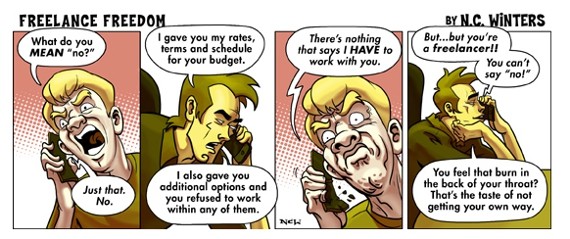“I’m sorry, but we have to let you go. You’re fired.”
I’m pretty sure that a lot us, freelancers, dream of wanting to be a real badass and say those words one day. Unfortunately, in the world of freelancing, having someone to fire is really not an option. Unless, you fire clients.
Yes. You can fire clients. A lot of blogs teach you how to get the right clients, and doing that can be very difficult, not to mention distressing, to budding freelancers. Often, you will surely get bad clients.
Table of Contents:
- Fire a Client
- How to Avoid the 6 Clients that Could Hurt Your Business
- 6 Things You Need to Explain to Your Clients Before Signing a Contract
The Freelance Designer Toolbox
Unlimited Downloads: 500,000+ Web Templates, Icon Sets, Themes & Design Assets
All starting at only $16.50 per month
Fire a Client
There comes a time, when you just cant work with someone anymore. This can also happen with clients. That’s why we have concluded this list when it’s time to just let a client go.
Why There Is a Need to Fire Clients
- Bad clients can hamper your productivity by bugging you with their problems
- Bad clients make your life difficult
- Bad clients take a lot of your time

Say, you came across this client. At first, he was great and all. He tried to understand your limits and said that he accepted them.
So, you both agreed to the terms of this business deal. However, as the project moved forward, he slowly began to become a jerk.
You became really stressed with him and began to doubt and ask yourself, “Was this project even worth continuing? What should I do?”
If you’ll ask me, I would say, “Fire Him”.
Now, there are debates as to whether you should fire a client or not. Some people argue that it diminishes your integrity as a freelancer and makes you a selfish and greedy bastard.
According to them, you also become a part of a generation with a very disturbed perspective. But I think that firing clients isn’t necessarily bad. In fact, it is good for business.
- Firing clients does not diminish your integrity at all; it even increases it. Turning down paid projects that you don’t like means having enough integrity to say no to things you don’t want to do.
- It doesn’t make you a selfish and greedy bastard either. As a matter of fact, you are showing signs of maturity and great decision-making.
- You also don’t reflect an askew perspective. In fact, firing a client means you have a very stable mind because you don’t let yourself become a slave of your client.
Now, let’s go to the reasons why you should fire a client.
The Price is Not Right

Most newbie freelancers start their business by trying to establish a name through client acquisition. Getting enough people to talk about you is surely a great way to set a reputation because word of mouth still is the best marketing tool.
It is in this aim that freelancers start with reasonably low prices. Of course, no big company will want to work with an inexperienced guy, right? So, targeting the smaller markets seem to be a very great decision.
When is the price not right?
- When the client offers you a very low price despite your level of experience and expertise.
- When the client refuses to pay an upfront fee.
- When the client renegotiates the pre-agreed fee in the course of the projects duration.
Demands Too Much

You probably experienced this before. Clients who demand too much to the point that you feel like you are a puppet who moves accordingly as the puppeteer lifts the strings. But let me tell you one bitter truth, all clients are demanding.
When does a client demand too much?
- If he calls or emails you every minute asking you how much of the job is done and you end up not finishing the project on time because he keeps on bugging you.
- If he starts to behave like that, fire him!
Disrespects and Insult You

I think you don’t need a lot of explanations for this. Fire your client if:
- Your client becomes too cocky and offensive
- Your client reams you with foul language, questions your ethics, condescends you, your family and your race
You don’t need to work with people like those clients. Remember that you became a freelancer to avoid bosses who are jerks. You should also avoid clients that are jerks.
If there is one thing in this world that you should never put up, it is insult.
If he can’t act like a grown up professional, then, you should.
- Don’t fight back, just ignore him and cut the deal.
- Don’t forget your manners.
There are a lot of jerks and arseholes in this world and you don’t need to add up to the list.
Goes Under the Hood

This is odd but there are clients who completely go off the grid at times. They don’t honor the times when you are supposed to meet and discuss your concerns.
- You send them emails, call them but they don’t seem to respond. When your client behaves like this, fire him.
You should always remember that communication is key to any relationship. Yours, even though it’s a business relationship, should be build with communication.
If he keeps on disappearing every now and then, then you won’t get work done because you have to spend a lot of time looking for him. And think of this, if he can’t talk to you regularly, do you think he’ll ever show up when you need him to pay?
Read these for more information:
4 Reasons To Fire A Client
4 Reasons to Fire a Client by Paul Spiegelman
When to Fire a Client
How to Fire a Client

We talked about why we should fire a client. Now, we move on to how.
Firing clients can be very difficult to do. Especially when you have to talk to him but it is something that needs to be done. If you keep on taking each blow your client gives you, you’ll end beaten up. You have to end this partnership or else, you have to suffer.
Think of firing someone as breaking up. Yes, there is no easy way to do it and surely, one will get hurt. There is no nice way of breaking up (or firing people) but we have to be mature and professional enough to do it.
- Turn him down respectfully
- Thank him, for everything that he’s done
- Write an email or a letter formalizing the decision
- Explain your reasons calmly
- Refer him to someone
Conclusion
Firing a client sure is hellish, but not firing a client is worse. As a freelancer, you have to make decisions that make you uncomfortable because you all need these to become successful. You can’t say Yes to everything. Fire him now, or suffer later. Which one will you choose?
These are measures that you should take when things go in the wrong direction. But as they say it’s better to prevent than to cure, we have some tips on which client types you should avoid.
How to Avoid the 6 Clients that Could Hurt Your Business
As freelancers we have a love/hate relationship with our clients. Without them we would be penniless, but at times they can make our work unbearably difficult. How do we handle the clients who don’t pay us, take all our time, and make our job harder than it needs to be? In my career I have worked with hundreds of clients and thankfully most have been amicable. But, every once in a while, one will come along that takes the wind out of my sails and this can potentially hurt my business if I let it. Knowing how to handle these unmanageable clients has helped me avoid potentially toxic situations.
These 6 client types top my list. Have you worked with any?
1. The Indecisive Client

Image by cobrasoft
Indecisive clients change their minds part way through the project. They add services and expect you to jump through hoops to get the work done. This client expects you to discard what you completed and start on an entirely new project while adhering to the same timeline. Back to the drawing board!
Here’s how to protect yourself:
- Pad your initial quote with some extra time. Every one of my projects has taken longer than I initially expected. It’s just the nature of the job.
- Work out every detail before starting the project. Craft an agreement that states exactly what the client will expect with additional time billed at xyz / hour.
- In your contract, include the number of revisions and a statement that breaks down the fees for any rush job, cancellation, or additional request.
2. The Expectant Client

Image credits
Did you ever work with a client who wanted Cadillac-type work on a Wal-Mart budget?
We are freelancers, not a subsidiary company of Donald Trump.
I like to work within my clients’ budgets. Some hail from startups or a bootstrapped situation and I am perfectly fine working with them as long as the rate makes sense for both parties.
But, if a client expects a “song and a dance” for little to no money, you can say “no”. Unless you are bartering your services for more exposure, or you are giving to an organization as a charitable contribution, you should be paid for your services.
Tip: Get the budget and payment agreement out of the way first. If you let a relationship progress before you talk budget, you will be more inclined to do the work for a lower rate. Beware of clients who do not openly discuss rates.
3. The Obnoxious Client
This is the client who took one web design course in college and thinks as a designer you are not doing the job exactly right. Or it’s the client who will never be satisfied with your work because she wants the results of a million-dollar agency on her meager budget.
How do you deal with these clients? Be patient and don’t take it personally. Sometimes people are insecure and they need to inflate their egos to feel better about themselves. Do your best job and kindly separate yourself from their negativity once the project is complete.
Tip: If you are not confident in your services, your clients will not be as well. You don’t have to be the “top dog” in your industry to give your clients an excellent product. Be confident in your level of expertise and you will attract a higher quality of leads who will appreciate the value you offer and pay you accordingly. I have first-hand experience with this.
4. The Insistent Client

Image Credits
In the beginning of my freelance writing career I had a client who wanted to work with me on her content even though the project was outside my comfort zone. After looking over the subject matter of the work, I decided the project was not right for me since the industry was out of my expertise and the client needed an expert on the subject. The client insisted that I work with her so I took the job anyway. I spent hours on the phone gathering the details of the project and a lot of time researching this particular industry so I could become familiar with the copy. Once the project began, I sensed the client changing her mind and she no longer wanted me to write for her.
Here are some lessons I learned from dealing with this type of client:
- If you feel the job is outside of your skillset, do not take it. No amount of money is worth it because an unhappy client creates more problems in the end.
- You are self-employed and do not work for a company. You have the right to turn down a contract if it does not suit your needs.
TIPS:
- Accept money upfront, especially if extensive research is involved. The percentage will depend on the project.
- Gather as many details about the project beforehand as possible. Many of my clients fill out questionnaires and sign an agreement so both parties are aware of what is required before we begin.
- If you are applying for freelance jobs, don’t let dollar signs influence the bulk of your decision making. If you can’t supply your client with excellent work, pass on it or hand it off.
- Gather a network of trusted professionals you can access when a project is outside of your scope of knowledge. The people in your network will also send clients your way when the project is better suited for someone with your skillset.
5. The Talkative Client
This client will email you in the wee hours of the morning and chat with you on the phone about everything from his dog’s name to where he wants to take his business.
Some projects will require more client communication than others but it’s important to set the time boundaries before you begin the project.
- Add your time commitment into your price quote.
- If you sense the client will be a time-sucker, add some money to your quote to make up for the extra time.
- Limit communication or charge for it separately.
I tend to err on the side of “free” communication for my clients because I want them to feel like they have an open door policy. When I feel clients are taking more of my time, I will nicely tell them I am busy and will get back to them as soon as I can. Train your clients to respect your schedule just as much as you respect theirs.
6. The Magician Client
I call this client the “magician” because he disappears once a payment is due! No contact; no correspondence; no request for further work; no explanation.
You spend hours designing a client’s website or writing copy and communication is going well. But once you request payment…
- Client is missing and out of touch
- Client mentions a family issue and tries to push off payment and is unreachable
- Client provides excuses and hopes you will eventually give up asking for money
I had one client who paid for partial services and owed me a final payment. I sent email after email and received word that she would send a check in one week. The week passed and I never received it. After numerous emails, she gave me an excuse about hardships she was facing. I offered my sympathy and told her I would be expecting payment. After more time had elapsed, I threatened to take further action. I received my payment days later.
Even with contracts, it’s hard to fight payment issues. Most of the clients are out of state or out of the country and fighting it in court is almost more headache than it’s worth, especially if you are only dealing with a few hundred dollars. If the situation escalates out of control, threaten to complain about their business whether on social media or any other media outlet., but only in extreme cases.
Assess this on a case by case basis. I had one client with whom I worked for a few years and her business went under. She owed me a lot of money but I haven’t escalated it because we had a good business relationship. Do everything you can not to escalate the situation, but know that you have options should the issue warrant it.
Here are some tips:
- Maintain steady communication throughout the project
- Communicate by phone – Clients have a harder time saying “no” on the phone.
- Request 25%-50% payment upfront.
Prepare for the Worst
The best way to prevent working with these clients is to learn from your mistakes and prepare for the difficult clients within your contracts.
Your contract should include:
- The scope of the project
- Deadlines and deliverables
- A detailed description of your services
- Revisions and fees for additional work
- Terms which include upfront payment, cancellation fees, etc.
It’s OK to turn down a project if something doesn’t feel right. Over time, you will develop an instinct about a client even before you submit a contract. Remember that you are hiring the client too. In the beginning you may need the money, but once you start building your business, choose your client similar to how they would choose you.
Your client is your customer and your goal is to please them. Do everything you can within your limitations to give them your best work. If all else fails, communicate that your working relationship is not beneficial for both parties and chock it up to experience. Hopefully no money is lost and you can move on from the negativity.
Have you worked with any of these clients? How did you resolve a client conflict? Well we’ve got you covered for this too. Ok, maybe not entirely, but to some point. Read on and find out what you should explain to your potential client before signing a contract.
6 Things You Need to Explain to Your Clients Before Signing a Contract
Contracts are binding and legal leverages that protect the interests and rights of both the designer and the client. These tie both parties to attune to the provisions of the contract and makes sure no one cheats over the other.
Also, these benefit designers greatly because:
- The designer will have some security that the client will pay
- The designer can withdraw the deal once he feels violated
- The designer will have an idea on how to react with clients who do not pay
What should be considered before signing contracts is no joke. This is to be taken seriously.
Once you sign, you need to finish the project and work well with the client as the client does with you. This is to preserve your reputation and of course, to follow the law.

Understanding the importance of contracts, you should always explain a few things to your clients before signing a binding and legal contract. You need to make them understand your terms so that both parties can work well together.
Here are a few things you need to explain:
Payment Schedules
As a freelancer, you have to assure that you are going to be paid. I mean, who works for free, right? That is why, as early as possible and before signing a contract, you have to discuss matters like payment schedules to your clients.
You need to ask the following:
- When am I going to be paid?
- How much is the upfront payment?
- How will I be paid?
- What are the necessary steps both of us should take in case of late payments or late delivery?

You have to do this in order to secure your efforts. You have to discuss this openly with the client. As a precaution, you might want to read Smashing Magazine’s article on clients who refuse to pay.
Delivery of Final Output
Of course, this item is included as one of the things you need to explain to your client. As a freelancer, you also need to give your client a sense of security. You need to assure that you’ll deliver at the date you both agreed.
Now, when it comes to setting a deadline for output, most freelancers divide the projects into segments or milestones. Each milestone has a deadline.
Example, you are to submit a web design for a restaurant website. As a freelancer, you will divide the whole project into four milestones. Say, first, you’re going to deliver the PSD of the layout and, second, the basic HTML page and so on.
Why are milestones important?
- Because the client will be able to see the progress of the project
- As a designer, you will be organized with your time frames
- You can make an agreement on the payment schedules based from the milestones

Now, if you’re going to ask me, who sets the deadline?
The answer here is simple. It’s not the sole right of the client to set deadlines. As a designer, you also have to explain your concerns to the client. Again, play safe. Give some extra time to your projected deadlines so that you can adjust easily when problems arise.
Of course, setting a deadline is never easy.
Here are a few tips:
- Assess the project well. Set realistic deadlines
- Explain to the client why you can’t meet his deadline and offer a win-win situation
- Play safe
- Include the smallest details in the plan
Here are a few other articles that might help you:
Regular Meetings and Updates
Meetings and updates are important to preserve a healthy client-to-freelancer relationship. You both have to decide the time of the day when you and the client are going to talk.
Save a few hours to voice out your difficulties and try to find a way to resolve them. Creating a routine where you both communicate properly will surely help. Remember, that you have to do this at a specified time only.

As a freelancer, you have to explain this to the client because most of them can go crazy with updating. We all know these types of clients. They nag and ask almost every minute for updates and sends numerous revisions which adds to the already heavy pressure that we are experiencing.
To address this, you have to open your mind and explain to the client that you can’t reply each time; you need a specific time and duration for these meeting so that you both won’t hamper each other’s productivity.
Here are a few guidelines to meetings and updates:
- Be straight to the point
- Update on the accomplishments first before stating the problems
- Try not to sound like whining when you state your problems
- Listen to the client
- Make sure that you note everything that you talked about.
For further reading: 10 Steps to the Perfect Client Meeting
Specs of the Project
Before signing that contract, you need to discuss the project with the client carefully. Of course, all of your efforts will be put to waste if you and the client won’t jive with your ideas. Heck, it may even go worse than that.

That is why it is important to talk about the contents of the project.
- What does the client want?
- What do you want?
- Would he need the website to be responsive?
- Will it be needed that you add some jQuery plugins?
Ask these questions and determine where you will both work well together. You have to be realistic to your client about this. You need to state what you can do and cannot do and explain how difficult it is for you to finish what that said client wants.
That way, you will preserve a good relationship where you both understand each other.
Design Revisions
Let’s imagine this scenario. You deliver a project to the client on time and on target. After a few days, the client contacts you for revisions. Now, you ask yourself, do I have to charge that said client for this?
This should be addressed before signing the contract. You have to assert that you will only give a limit of three revisions for the entire project.
This is an important aspect of freelancing because you have to preserve your reputation as you would want to deal with the client with extra care and compassion. But you also have to protect yourself and your interest.

This article talks about what the number of revisions that you should allow. Now, I ask, you, do you agree with this?
Client Feedback
As a designer, having a portfolio is really important- and part of building a solid portfolio is having enough testimonials from your previous clients. This is not an urgent matter, though. But you have to get your client’s feedback from your work.

Why is this important?
- To assess yourself and discover your strengths and weaknesses
- To assess your system
- To build a stronger portfolio
Now, what can I recommend when it comes to getting client feedback?
- Prepare a template of questions
- Keep the questions short and direct to the point
- Use tools like:
- Pandaform
- Surveymonkey
- Wufoo
- Get regular feedback before submitting revisions
For further reading: How To Get and Use Customer Feedback
Conclusion
As I’ve stressed at the beginning of the article, signing contracts can be very complicated and could result to future headaches once breached. That is why, before entering into an agreement, you have to make sure that both you and the client have understood what both of you want. This is not only about legality, but about preserving a sound working relationship that could lead into successful partnerships in the future.
This post may contain affiliate links. See our disclosure about affiliate links here.




